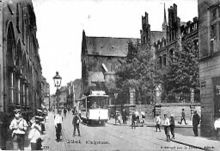Koenigstrasse (Lübeck)


The Lübeck Königstraße 's Cultural Mile and the second shopping area of the Hanseatic city .
Surname
The designation as Königstraße is not a reference to a Via Regia as Altstraße that already existed when the city was founded , but a name from the early 14th century, which extended from the section between Aegidienstraße and Wahmstraße in several individual steps to the entire current street from 1307 until 1325. Ahasver von Brandt leads the designation on the assumption of protection by King Erik VI. Menved in 1307 as an umbrella Vogt back in town.
course
It runs from Koberg as an extension of Große Burgstraße parallel to Breite Straße and joins Mühlenstraße , which leads south out of Lübeck city center. It is thus the main component of the basic urban planning of the 12th century that is still valid today. From this north-south connection, which consists of four streets, all the other streets go off at right angles, but are again connected at right angles in blocks by even smaller cross streets .
The first part, beginning with the Heiligen-Geist-Hospital and the Jakobikirche , leads through a closed classical ensemble with the society house of the Society for the Promotion of Charitable Activities (No. 5/7) and the Museum Behnhaus (No. 9/11) as the center . This part can also be accessed from the back through the community gardens as a park .
Between 1886 and 1903, Roquette's private teachers' seminar was located at Königstrasse 15 . After it was closed, the associated Roquette Higher Töchterschule continued until 1912.
On the right-hand side is the Reformed Church (No. 18), a result of a conversion (1824–1826) of a baroque city palace in the style of revolutionary architecture . During the unrest of 1848, the Lübeck Senate fled to this building. Thomas Mann in the Buddenbrooks and Ludwig Ewers in his grandfather city address this event.
The former house of the influential Junker and Zirkelgesellschaft (No. 21), to which the cream of the Lübeck merchants belonged, was given its facade that is preserved today by the latter in 1770. In 1822 it became the property of the city, which rebuilt it for the Higher Appeal Court of the four Free Cities of Bremen , Frankfurt am Main , Hamburg and Lübeck, which had its seat there until the Reich Justice Acts came into force in 1879. From 1881 to 1936 it then served as the seat of the Lübeck State Archives , which took the meeting table of the Higher Appeal Court to its new premises. After the State Archives, the public library was located there. In 2007 it was opened as Willy-Brandt-Haus Lübeck , the branch of the Berlin Federal Chancellor Willy Brandt Foundation , in honor of Willy Brandt in his hometown. A gallery in the gabled house has a group of allegorical figures created by Dietrich Jürgen Boy . They represent peace and harmony as well as the coat of arms of the circle society.
At the intersection with Glockengießerstraße and Pfaffenstraße , the latter is a small pedestrian zone that connects Königstraße with Breiten Straße and Beckergrube . After the intersection with Glockengießerstraße , the former Katharinenkloster with the Lübeck Katharinenkirche , the Katharineum and the city library behind it , which has its entrance on Hundestrasse . Königstrasse is now turning into a shopping street with shops, department stores and a shopping arcade .
At the corner of Dr.-Julius-Leber-Straße you will find the brick Romanesque Lion Pharmacy, the oldest preserved secular building in Lübeck. As a youth, Erich Mühsam campaigned for its preservation in one of his first articles.
The Fleischhauerstraße and Hüxstraße transverse to Königstrasse extending shopping areas with smaller, individually managed stores. With over 120 shops and restaurants, Hüxstraße is considered the most interesting shopping street in Lübeck. Both streets are pedestrian zones in the upper part between Königstraße and Breite Straße. On the corner of King Street and Fleischhauerstraße extends from Schrangen from the Königspassage as a small shopping center . The Lübecker Nachrichten publishing house was located in this quarter between Königstrasse, Dr.-Julius-Leber-Strasse and Fleischhauerstrasse until 1991 .
The Königstraße is traffic-calmed, but not a pedestrian zone as a route for bus traffic.
Listed buildings
Under conservation building 5-31 are (including the building Königstrasse 25 ), 43 , 47-57, 79-85 (including the building Königstrasse 81 ) and 93 odd and the houses 2-8, 12, 16, 18-20, 28-30, 42, 60, 74, 80, 110-112 and 118 straight.
- See also list of abandoned buildings in Lübeck # Königstrasse for buildings that are no longer in existence.
Corridors and courtyards
The following two Lübeck corridors and courtyards started from Königstraße (according to house numbers):
- 3: Kohpei's gateway
- 131: Holdorf's gang
New buildings
The structure of the former Haerder department store between Königstraße, Wahmstraße and Sandstraße was completely demolished in 2006 and was rebuilt with a vertical shopping center with over 10,000 m² of retail space and opened on October 30, 2008. The project was the largest construction project in Lübeck's old town after the reconstruction after the air raid on Lübeck on March 29, 1942 . The only thing that was affected by the demolition was the reconstruction of the post-war period , which no longer met today's retail requirements.
Königstrasse 42, former Reichsbank branch in Lübeck by Max Hasak (1894)
literature
- Ahasver von Brandt : Koenigstrasse = Via Regia? On some problems of the early history of Lübeck in: ZVLGA Volume 32 (1951), pp. 70–86
Web links
See also
Coordinates: 53 ° 52 ′ 3.4 " N , 10 ° 41 ′ 16.5" E






